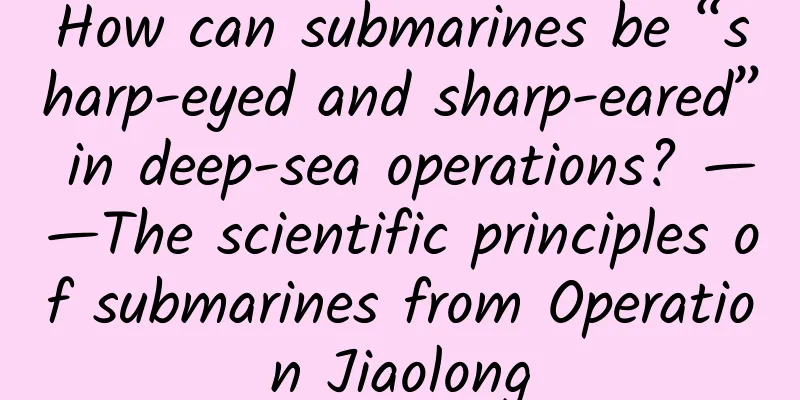How can submarines be “sharp-eyed and sharp-eared” in deep-sea operations? ——The scientific principles of submarines from Operation Jiaolong

|
As the sequel to "Operation Red Sea", the box office champion of the 2018 Spring Festival, "Operation Jiaolong" was released during the Spring Festival of the Year of the Snake. It not only continued the excitement of the previous film, but also for the first time in the history of Chinese screens, it used the Chinese People's Liberation Army Navy submarine force as the protagonist, showing the thrilling deep-sea operations of this "mysterious force". In the film, the Jiaolong Commando dives into the mysterious deep sea world, leading the audience into a realm that is completely different from land. The high pressure, low temperature and darkness of the deep sea are enough to daunt people, but the soldiers are not afraid, driving advanced submarines and quietly moving forward under the waves. The advanced submarine technologies displayed in the film, such as anti-torpedo torpedoes, supercavitating torpedoes, superconducting magnetofluids, shaftless pump-propulsion, and underwater transport boats, are an eye-opener for the audience. The military use of submarines is to make full use of their ability to lurk underwater, to "plot against" the enemy unexpectedly, to take advantage of their unpreparedness and attack them unexpectedly, which can be said to be a hidden murderous intention. Do you know the history of submarine development? How do submarines achieve free sinking and floating? Why are submarines not crushed by water pressure when diving? How do submarines achieve "sharp hearing and eyesight" in the water? Let’s answer it together today ↓↓↓ ▲Navy Museum Exhibition The birth history of "brain-opening" Legend has it that the concept of "diving underwater" already existed in the time of Alexander the Great before Christ. The diving device at that time was as shown in the figure below, which could not actually be considered a submarine. If non-military submarines can be traced back to 1620, Dutch scientists successfully built the first "submarine boat" in human history, which could be driven by 12 sailors paddling and had dived into water more than 5 meters deep in the Thames River in the UK many times. ▲The first "submersible ship" in human history Over the next 100 years, scientists from various countries used their imaginations to create a variety of submersibles. Some looked like large boxes, some looked like balls, and some even looked like kettles. However, there were no major breakthroughs in technology and application. It was not until the outbreak of the American War of Independence in the late 18th century that new impetus was injected into the development of submarines. ▲“Kettle” submarine David Bushnell of the United States developed the "Turtle" submarine, which looks like a big ball. The water tank is filled with water by pedaling and it is propelled by a hand-cranked propeller. It can dive 6 meters underwater and stay for 30 minutes. ▲"Turtle" submarine Late in the night of September 7, 1776, a loud explosion suddenly occurred near the British Royal Navy's Eagle, which was responsible for blockading the port, outside the New York Harbor. Upon hearing the explosion, the British warships weighed anchor one after another, while the uninvited guest, the Turtle submarine, which had previously sneaked under the keel of the warship, had already evacuated quickly under the command of U.S. Army Sergeant Ezra Lee. Although this "sneak attack" was not successful, it marked the beginning of submarine combat and expanded the battlefield space of mankind from land and water to underwater. With the deepening development of the Industrial Revolution, steam engines were applied to submarines, and the maneuverability of submarines equipped with steam engines was greatly enhanced, and submarines also ushered in a period of rapid development. At the end of the 19th century, John Philip Holland, an engineer born in Ireland, combined the three technologies of electric motors, batteries and internal combustion engines and applied them to submarines. After that, through continuous technological improvements, he finally built the legendary submarine "Holland 6" powered by gasoline engine + battery in 1897. This submarine is recognized as the ancestor of modern submarines, and Holland is also honored as the "Father of Modern Submarines". In 1900, the USS Holland became the first submarine to enter service in the U.S. Navy, and six submarines were in service by 1905. After that, the Holland submarine was purchased and copied by Britain and Japan, ushering in the modern submarine era. The secret of submarines' free sinking and floating Submarines can dive, float, and even hover freely in the water. The principle is actually a kind of bionics. There is an organ called the swim bladder in the body of fish, which can shrink or expand under the control of muscles. When the swim bladder is filled with air and expanded, the buoyancy of the fish in the water is greater than the gravity, and the fish floats up; when the swim bladder shrinks, the buoyancy of the fish is less than the gravity, and the fish sinks. Inspired by this, people also installed a hull similar to a swim bladder on the submarine, which is the hull on both sides of the submarine called the main ballast tank. The function of the main ballast tank is to realize the submarine's diving and surfacing by filling and draining water. When diving, the main ballast tank is filled with water, and the air is discharged from the cabin, the submarine's own weight increases, and the cabin sinks. When surfacing, the water in the main ballast tank is pressed out of the boat with high-pressure gas, the submarine's own weight is reduced, and the submarine can float to the surface. In order to better control the state of the submarine, people also installed auxiliary ballast tanks such as heavy water tanks and fast diving tanks on the submarine. For example, after launching a torpedo or missile, the weight of the submarine will change. At this time, a heavy water tank is needed to compensate for the weight of the torpedo and missile that have been launched. In an emergency situation where a rapid dive is required, it is not enough to rely on the main ballast tank alone. The help of the fast diving tank is also needed to speed up the submarine's diving speed. In addition, most submarines are also equipped with horizontal rudders, also called elevators, which can interact with water when the submarine is moving, thereby generating torque, allowing the submarine to pitch up or down, and move upward or downward. How submarines fight water pressure Submarines are usually designed in a circular or teardrop-shaped structure. The advantage of such a structure is that the pressure of seawater can be evenly distributed in all directions, so that the water pressure it brings is consistent and it is not easy to have uneven force. At the same time, it can also effectively reduce the resistance of navigation in the water and reduce the sound generated by friction with water. Of course, the hull shape alone is not enough to withstand the pressure of seawater. When building a submarine, high-strength steel is needed to build the submarine's annular rib frame, and then wrap the hull with pressure-resistant plates to achieve the effect of balancing the water pressure. The pressure-resistant plate is mainly made of composite mesh steel during construction. You may understand it by taking an example. If we use a newspaper to cover a window hole, it will be easily blown away by the wind. If we add a layer of screen behind the newspaper, it will be much better. If the screen is fixed with criss-cross wires, the wind can blow it. In fact, the manufacturing principle of submarine pressure-resistant plates is also the same. At present, the strength of the pressure-resistant hull of submarines in the world can generally ensure that the submarine can dive to 300 meters to 1200 meters. Submarine positioning tool When a submarine is "on its back" on the sea surface, it generally uses a periscope to directly observe the state of the sea surface. The principle of the periscope is to use two reflectors to bend to the eye after two reflections. The reason why the periscope can see the water surface from underwater and is relatively clear is that the two plane mirrors are parallel to each other and are at a 45-degree angle to the horizontal direction. The scene is reflected and imaged twice, so that the scene on the sea surface can be seen. Now with the development of optoelectronic technology, optoelectronic masts are gradually replacing traditional periscopes. Optoelectronic masts are a device similar to a monitor set at the top of the mast. The monitor can directly view the place monitored by the monitor on the display screen in the submarine cabin, which makes the submarine's "eyes" vision even better. When a submarine is "diving" in the ocean, because of the pitch-black ocean environment, neither the periscope nor the optoelectronic mast can see the surrounding environment clearly. At this time, the submarine's "ears": sonar comes in handy. Since the attenuation of sound propagation in the ocean is relatively small, and the sound will turn around and return when it encounters a large obstacle in the ocean, sonar uses the above-mentioned characteristics of sound propagation and reflection in water to convert and process the sound through a series of electronic devices to obtain information such as the existence, location, nature, and direction of movement of underwater targets. In the deep sea, sonar is like a pair of sensitive "ears" in the dark. Through this pair of "ears", the submarine can discover other large targets in the ocean and evade and attack them. As an important force in the modern navy, the development and application of submarine technology not only reflects the crystallization of human wisdom, but also an important guarantee for national security and maritime rights and interests. With the continuous advancement of science and technology, future submarines will be more advanced and more intelligent, and they will continue to guard national security and maritime peace in the deep sea. Source: China Daily, Chinese People's Liberation Army Navy Museum, China Maritime Museum, CCTV Military, etc. Editor: David Duan |
Recommend
Why has Google failed to get Android development on track?
Introduction It's 2015 now, mobile is the new...
Detailed explanation of Sina Fuyi advertising resources!
Here is the Fuyi APP resource promotion plan cove...
How to build a good reputation for a product during its introduction period?
Today let’s talk about a not very interesting que...
In the era of mobile Internet, how can we find accurate users and obtain first-hand traffic at the lowest cost?
How can we find the precise users of our products...
Bandwidth and storage costs of renting Tik Tok short video servers
The field of short videos has increasingly become...
Zhong Xue Gao Brand Marketing History
When it comes to Zhong Xue Gao , it is definitely...
Complete guide to Tik Tok operations and the law of attraction!
This article explains the operation of TikTok fro...
Double Eleven express delivery has arrived one after another, the correct way to receive express delivery →
On November 13, the State Post Bureau issued a no...
Sony Bluetooth Speaker SRS-HG10 vs. BOSE Soundlink Mini II: Powerful low-frequency speakers are not afraid of the test
Comparing and evaluating speakers is a thankless ...
The operation model of increasing 100,000 followers at 0 cost: budget ≠ resources
We are at a loss in the anxiety of zero budget, b...
The 8 most meaningless code comments
Over the years, I've had the great pleasure o...
What kind of copywriting can make users eager to click the "Buy" button?
Compared with the "heart", "tone&q...
Military Advisor's Office Four Pillars Learning Elementary and Intermediate Class
Resource introduction of the Military Advisor'...
How is maternal genetic relationship determined? | The scientific principle of DNA paternity testing
The advent of DNA profiling has greatly improved ...
After working on information flow for half a year, I found these 3 points to be super useful!
When it comes to information flow , I think most ...









